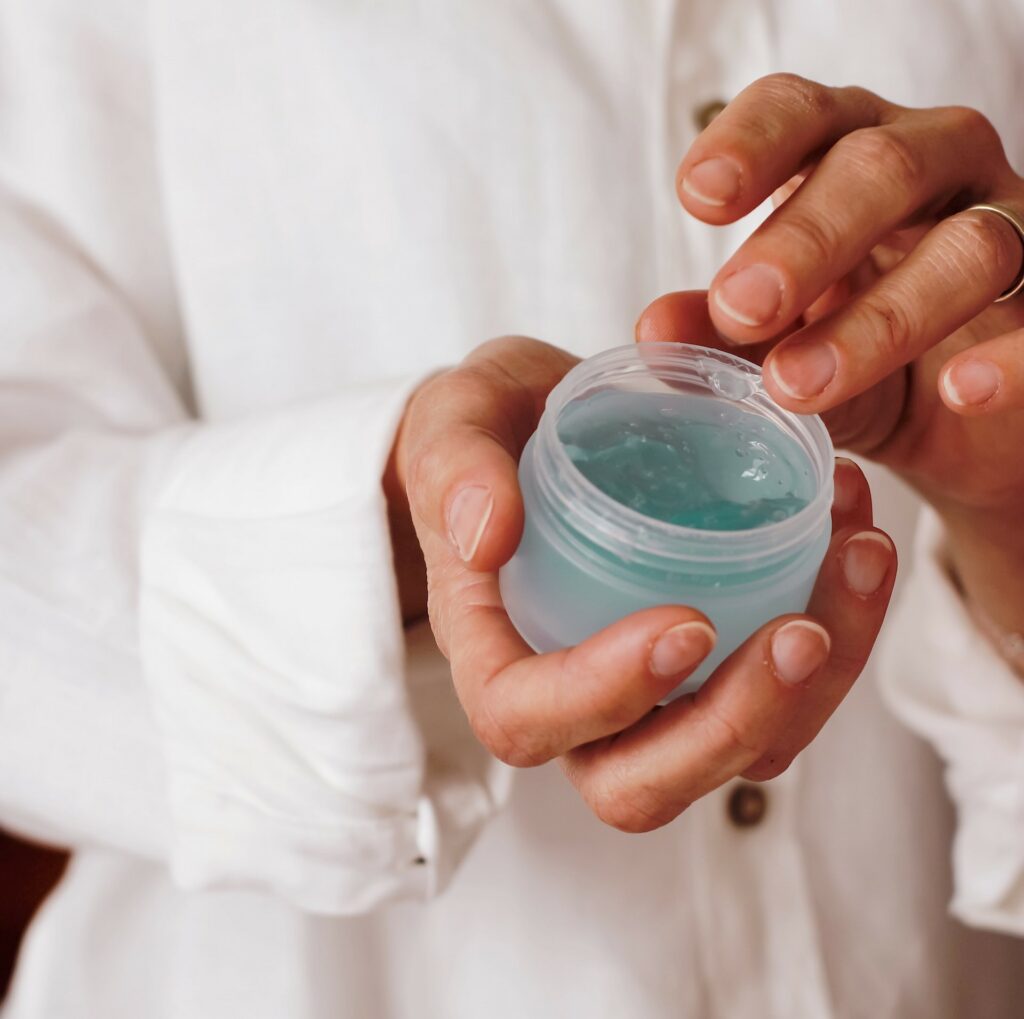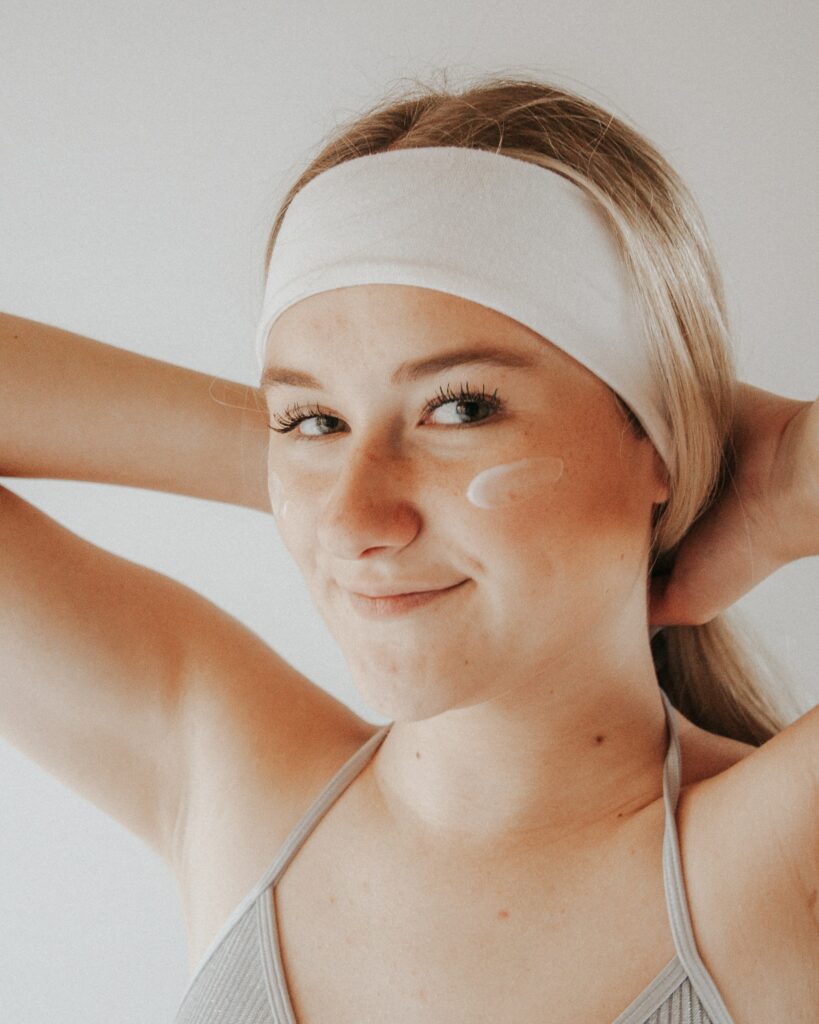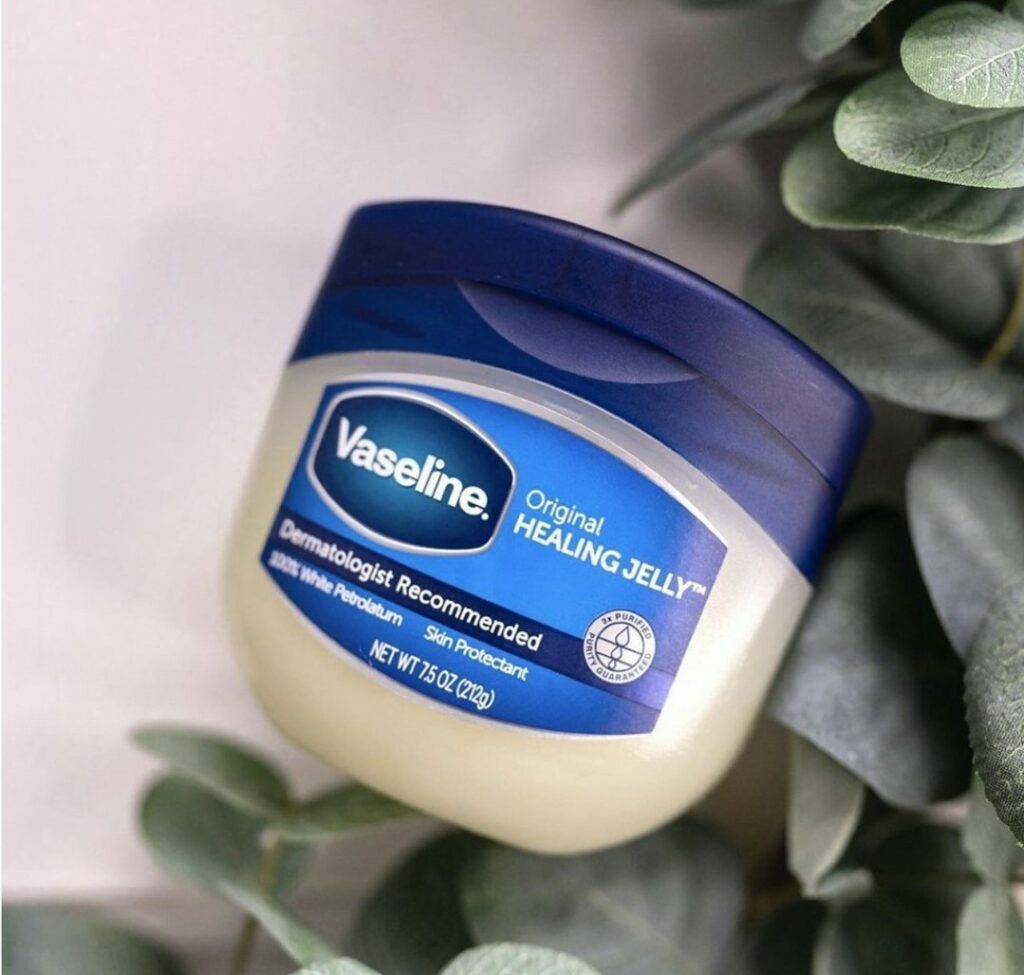Table of Contents
Today, we’re diving into a topic lighting up beauty forums, flooding Instagram comments, and stirring up a virtual riot in the makeup world — the unexpected use of Vaseline as a makeup primer. That’s right! We’re talking about that humble little tub sitting on your bathroom shelf, overlooked and underestimated. A staple of our childhood medicine cabinets, a champion of chapped lips and dry elbows, Vaseline has been touted as the newest makeup marvel. But does it live up to the hype? Does it truly deserve a spot in your coveted makeup routine?
As we embark on this thrilling journey of discovery together. In this post, we’ll explore the science behind Vaseline and its potential as a primer, weigh the pros and cons, and put it to the test against the well-established, high-end primers on the market. We’ll also touch on how it interacts with various skin types and explore whether its petroleum jelly base can offer your makeup the smooth canvas it needs to shine.
With all the expertise of a seasoned beauty blogger, in-depth research, and a sprinkle of makeup magic, we’re about to shed some light on this perplexing primer possibility. So, let’s get our glam on, stir the beauty pot, and find out if Vaseline is the unexpected makeup primer you never knew you needed!
Unmasking Vaseline: A History Lesson
Ever wondered what Vaseline is? Well, it’s time for a quick beauty history lesson. Vaseline, a staple of our skincare arsenal for over 140 years, was first introduced by Robert Chesebrough in 1859. The discovery happened when he noticed oil rig workers using “rod wax” to soothe minor cuts and burns. This was the birth of petroleum jelly, eventually rebranded as our beloved Vaseline.
Vaseline’s journey is as versatile as its uses, from a humble healing ointment to a cherished part of beauty rituals worldwide. It’s been our go-to for moisturizing dry skin, taming curly hair, and even treating minor wounds. It’s like that dependable friend who always has your back — no matter what skincare crisis you face!
The Many Faces of Vaseline: Intended Uses

Vaseline’s primary claim to fame is as a savior for dry, chapped, or irritated skin. It’s like an invisible barrier, locking in moisture and protecting against the elements.
Have you ever got that stubborn waterproof mascara that just won’t quit? Guess what? Vaseline can help! It’s gentle yet effective in breaking down and removing makeup. And when it comes to lips, not only does Vaseline help soothe chapped lips, but it can also act as a primer, preventing your lip color from bleeding.
Speaking of primers, we must remember their star turn in hair care. A smidgen of Vaseline can work wonders in taming flyaways, adding shine, and even providing heat protection. Who knew this multitasker had so many tricks up its sleeve?
Vaseline: Friend or Foe to Skin?

Despite its long history, Vaseline’s safety as a skin care product has been a hot topic. The primary ingredient, petroleum jelly, is derived from crude oil, which does have a reputation for being comedogenic (aka pore-clogging) and potentially tricky to remove. This can lead to skin build-up, which nobody wants.
However, it’s essential to remember that Vaseline is non-toxic and hypoallergenic. So, for most people, it’s completely safe. It’s a trusty ally in the fight against dry, chapped skin; let’s face it, there’s nothing quite like its instant soothing effect!
But, as with all skincare products, the golden rule is moderation. And if you’ve got sensitive skin or a history of breakouts, you should test it before committing fully.
So, that’s the lowdown on Vaseline, our unassuming beauty superhero. Stay tuned for the next segment to investigate whether Vaseline cuts a makeup primer. Spoiler: the answer might surprise you!
Vaseline as Clear Mascara: A Natural Shine
Here’s a little secret. Did you know that Vaseline can work its magic as clear mascara? I’m not saying it’ll give you dramatic volume or spectacular curls — that’s not Vaseline’s style. Instead, it adds a beautiful gloss to your lashes, making them look long and lush.
I recall running out of mascara one time, and what came to my rescue? Yes, Vaseline! A swipe with a clean mascara wand or spoolie and my lashes were set with a fresh, dewy look, with no toxic ingredients.
A bonus? Your wallet will thank you for the change. And who can resist beauty on a budget?
Vaseline as Makeup Primer: Smooth Canvas, Here We Come!

Most of us love a good makeup primer. That perfect base fills in fine lines, blurs pores, and ensures our makeup stays in place. But have you ever thought of using Vaseline as a primer?
My friends, Vaseline is a fantastic occlusive agent that creates a protective barrier on the skin, locking in moisture and keeping your foundation from vanishing into your pores. Its emollient properties can help soften your skin, providing a smooth canvas for makeup application.
Applying Vaseline as a primer is as easy as spreading a thin layer on your face using gentle, circular motions before moving on to your foundation. Let it absorb fully; voila, you’ve got a skin-loving primer ready to rock your makeup look. If you prefer a more lightweight feel, try mixing a bit of Vaseline with your regular moisturizer.
Vaseline as an Eyeshadow Primer: Proceed with Caution!
While some makeup gurus might rave about Vaseline as an eyeshadow primer, be mindful. Its thick texture could cause your eyeshadow to crease or clump. Here’s a trick I learned: Apply a tiny amount of Vaseline and then dust a light layer of translucent face powder before putting on your eyeshadow. This combo creates a smoother, longer-lasting base for your eye makeup.
The Vaseline and Foundation Debate: Resolved!
There’s a myth out there that Vaseline can break down your foundation. Time for some myth-busting! The greasy nature of Vaseline creates a barrier between the foundation and your skin, preventing the foundation from being absorbed. So, far from breaking it down, Vaseline can help your foundation last longer.
Vaseline as a Moisturizer: Not Just a Pretty Face
Vaseline isn’t just great at playing different roles in your makeup routine; it’s also a trusty skin hydrator. It forms a barrier, preventing water loss — a blessing for those struggling with dry skin conditions like eczema.
However, it’s worth noting that Vaseline is petroleum-based, which means it can be too heavy and may not let the skin breathe, making it less ideal for acne-prone or sensitive skin types. Always patch test before using petroleum products over large areas.
That’s the inside scoop on Vaseline, a versatile beauty companion! Remember, knowledge is power in the world of beauty. Stay tuned for more juicy beauty secrets in our next rendezvous. Until then, stay fabulous!
Vaseline Meets Foundation: A Love Story?

The debate has been raging: to mix or not to mix Vaseline with your foundation. To set the record straight, many foundations indeed contain petroleum jelly, making the blend smoother and gliding on like a dream.
However, from my beauty escapades, I’ve found that mixing the two is only sometimes necessary. Applying foundation over a light layer of moisturizer can give equally pleasing results. But if curiosity gets the better of you and you decide to play beauty mixologist, remember, less is more.
Why? Too much Vaseline can make your face slippery, making the foundation slide off. Overdoing the liquid foundation can leave your skin under a heavy, cloggy blanket – a nightmare scenario for my oily skin comrades!
Vaseline as a Makeup Remover: A Messy Affair?

Is Vaseline a makeup remover candidate? Let me give you the lowdown. It can break down and remove makeup when used with warm water, but it isn’t the top of the class. Especially when dealing with demanding customers like waterproof mascara and long-wearing foundation, Vaseline can struggle.
Plus, I remember trying to wipe off my makeup with Vaseline one evening after a glamorous event. Let’s say it turned into a rather messy affair. I’d still vouch for a makeup remover, preferably oil-based, explicitly designed for the job – that’s one beauty lesson I’ve learned.
Vaseline: A Subtle Highlighter in Disguise?
Last but not least, is Vaseline a secret highlighter? Well, it’s not a conventional one. Sure, it reflects light and can give your skin a luminous effect, but it could be better with a traditional highlighter.
One hot summer day, I decided to dab Vaseline on my cheekbones as a makeshift highlighter. It initially gave me a dewy look, but as the day progressed, it started sliding down my face (a greasy slip-n-slide!).
So if you want to channel that subtle, dewy glow using Vaseline, go easy on the amount and blend well. Just remember, it won’t entirely replace the dazzling effect of a bona fide highlighter.
There you have it, my lovelies! That’s your fresh dose of beauty insights centered around our trusty jar of Vaseline. Until next time, keep shining and experimenting in your unique beauty journey!
What Are The Pros And Cons Of Using Vaseline As A Makeup Primer?
Pros:
- Moisturizing: Vaseline is a humectant that locks in moisture, leaving the skin soft and hydrated. This can give a smooth, hydrated base for makeup application.
- Creates a barrier: Vaseline creates a barrier between your skin and makeup, which can help makeup last longer by preventing it from soaking into your skin.
- Affordable: One of the great things about Vaseline is its price. It’s significantly cheaper than most commercial makeup primers, making it an excellent budget-friendly option.
- Accessible: Vaseline is a widely available household item, so you’re never too far away from your primer!
Cons:
- May cause breakouts: Vaseline is occlusive, meaning it can clog pores. This can lead to breakouts, especially for acne-prone or oily skin.
- Not ideal for all types of makeup: Certain types may not adhere as well to a Vaseline base as they would to a traditional primer. This might affect your makeup’s performance throughout the day.
- Can feel heavy: Some people may find Vaseline’s texture too heavy or greasy for their liking, which can make it uncomfortable to wear under makeup.
- Difficult to remove: Vaseline can be tricky to wash off, so you might need to do a bit more work to properly cleanse your skin after wearing it under makeup.
| Aspect | Vaseline | Other Makeup Primers |
|---|---|---|
| Price | Generally cheaper, commonly available in most households | Varies greatly by brand and product; generally more expensive than Vaseline |
| Performance | Forms a protective barrier, maintains skin hydration, but may cause makeup to slide | Specifically designed to hold makeup in place, reduce creasing and prolong wear time |
| Skin Compatibility | Can potentially clog pores; better for dry skin, not ideal for oily/acne-prone skin | Varies by product; many options for all skin types, including sensitive and acne-prone skin |
| Feel & Look | Greasier texture, may give a dewy finish | Depending on the product, can range from matte to dewy finish, some with smoother or lighter texture |
| Ingredient Safety | Generally safe, but derived from petroleum, a non-renewable resource | Ingredients vary by product; many safe options, including organic and mineral-based primers |
| Ease of Removal | Can be more difficult to remove, leading to potential skin buildup | Generally designed to be easily removed with standard makeup removers |
Remember, everyone’s skin is different, and what works for one person might not work for another. It’s always a good idea to test a new beauty routine on a small part of your skin before applying it to your whole face, especially if you have sensitive or acne-prone skin. Enjoy experimenting!
How Does Vaseline Interact With Different Skin Types?
The effects can vary when it comes to Vaseline, or petroleum jelly, interacting with different skin types. Let’s break it down:
- Normal Skin: Vaseline can be a useful moisturizer for those with normal skin, creating a protective barrier that locks in natural moisture. It’s often used for hydration and can effectively prevent dryness and flakiness.
- Dry Skin: Vaseline can work wonders if you’re prone to dry skin! Its occlusive properties help trap moisture in the skin, preventing water loss and effectively combating dryness. Its thick, emollient nature immediately relieves dry, chapped skin, whether on your face, lips, or body.
- Oily Skin: Those with oily skin should approach Vaseline with caution. Due to its occlusive nature, it can clog pores and contribute to increased oiliness or breakouts. If you have oily skin and still want to try using Vaseline, it’s best to use it sparingly and in targeted areas only rather than over the entire face.
- Combination Skin: The response to Vaseline can be a mixed bag for those with combination skin. It might work well on the dry areas of the skin that need more moisture, but it could make the oily areas oilier.
- Sensitive Skin: Vaseline is generally safe for sensitive skin. It’s non-irritating and hypoallergenic. However, if you’re sensitive to specific ingredients or your skin is prone to conditions such as rosacea or eczema, it’s always best to do a patch test first or consult a dermatologist.
- Acne-Prone Skin: Using Vaseline might not be the best idea for those with acne-prone skin. As it can clog pores, it could lead to more breakouts. Always consult with a dermatologist if you need clarification.
Remember, each individual’s skin is unique, and reactions can vary. Always listen to your skin; if something doesn’t feel right, it’s best to stop using and consult a dermatologist or skincare professional.
Get The Facts About Vaseline & Sensitive Skin
Vaseline, or petroleum jelly, is generally considered safe for sensitive skin. It’s a simple product with a minimal ingredient list, free from fragrances, dyes, and common irritants that might cause reactions in sensitive skin types. It’s also non-toxic and hypoallergenic, so that most people can use it without issues.
Those with a history of breakouts or acne-prone skin should approach Vaseline cautiously. Vaseline is occlusive, meaning it forms a barrier on the skin. While this barrier is excellent for locking in moisture, it could also trap oil, dirt, and dead skin cells in the pores, potentially causing or exacerbating acne.
For some people, Vaseline might not cause breakouts at all, while for others, it could lead to blocked pores and acne. A lot depends on your skin and how it reacts. If you have a history of breakouts or acne, it’s a good idea to use Vaseline sparingly and monitor your skin’s response closely.
And of course, always consult with a dermatologist or skincare professional when in doubt. They can provide personalized advice based on your unique skin type and history.
Conclusion
And there you have it, my beauty enthusiasts! We’ve journeyed together through the myriad of ways you can incorporate our trusted Vaseline into your beauty regime. As a humble but mighty multitasker, Vaseline can be used in ways you might not have imagined. Vaseline has proven itself worthy of a place in your beauty arsenal, whether it’s makeshift mascara, a quick primer, a skin barrier, or even a subtle highlighter. However, as with any beauty product, remember its potential drawbacks. Its thick texture could lead to pore-clogging or potential messiness.
Above all, remember that beauty is all about exploration and personalization. What works for one may only work for some, so be bold, experiment, and find out what makes you feel fabulous. After all, the journey brings joy, not just the destination. So grab that jar of Vaseline, get creative, and let’s continue to write our own beautiful stories together. Stay glowing and stay beautiful, my friends!
Feature image by Fleur Kaan on Unsplash




